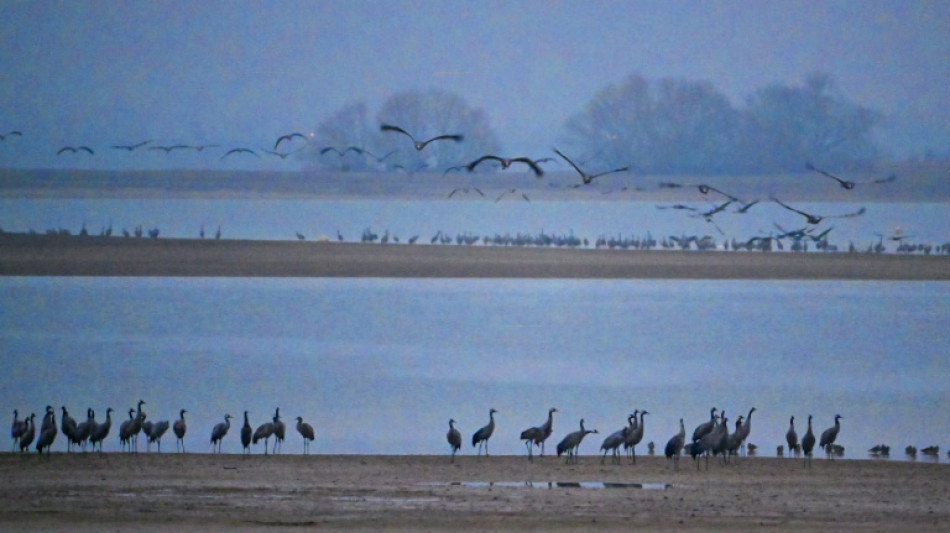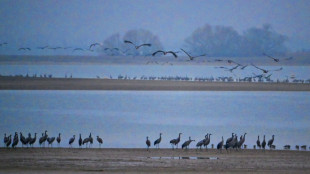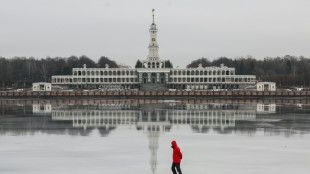
-
 Man Utd lose to Palace, Spurs ease pressure on Postecoglou
Man Utd lose to Palace, Spurs ease pressure on Postecoglou
-
Rubio meets Panama leader on Trump demands for canal

-
 Starmer hails 'real progress' on UK-Germany ties at Scholz talks
Starmer hails 'real progress' on UK-Germany ties at Scholz talks
-
Abhishek's 135 fires India to 247-9 in final T20 against England

-
 Trump says tariff 'pain' will be 'worth the price'
Trump says tariff 'pain' will be 'worth the price'
-
Lewandowski earns Barca win over Alaves to preserve title hopes

-
 Rybakina adds Sanguinetti to coaching staff
Rybakina adds Sanguinetti to coaching staff
-
England women's chief admits team out-played 'in every facet' after Ashes humiliation

-
 Global warming makes French reservoir a winter resort for migrating cranes
Global warming makes French reservoir a winter resort for migrating cranes
-
Kolo Muani double helps Juve to Empoli win, Inter set for key Milan derby

-
 Jones says Scotland must end Ireland losing streak to prove Six Nations worth
Jones says Scotland must end Ireland losing streak to prove Six Nations worth
-
Borthwick urges England to be a 'better team' against France in Six Nations

-
 Morata set for loan to Galatasaray from AC Milan
Morata set for loan to Galatasaray from AC Milan
-
Ajax loan English forward Chuba Akpom to Lille

-
 Man Utd sign Dorgu from Lecce
Man Utd sign Dorgu from Lecce
-
Netanyahu heads to US for pivotal Trump talks

-
 Fangio's Mercedes 1954 F1 car sold for record $53 mln at auction
Fangio's Mercedes 1954 F1 car sold for record $53 mln at auction
-
Residents near Japan sinkhole urged to evacuate

-
 China shrugs off new Trump tariffs but bruising trade war looms
China shrugs off new Trump tariffs but bruising trade war looms
-
Is it Beyonce's time? Music's A-listers ready for the Grammys

-
 Swiss champion Schmid wins Cadel Evans Road Race in scorching heat
Swiss champion Schmid wins Cadel Evans Road Race in scorching heat
-
Cash-keen Taliban betting on Afghanistan's mines

-
 Seeking light in dark times four years after Myanmar coup
Seeking light in dark times four years after Myanmar coup
-
Autos, electronics: What will Trump's tariffs impact?

-
 Three things we learned in the Six Nations
Three things we learned in the Six Nations
-
Russia and Ukraine trade blame for attack on Kursk school

-
 For world's poorest, fears for long-term setbacks after Trump aid cut
For world's poorest, fears for long-term setbacks after Trump aid cut
-
Chappell Roan: the splashy pop supernova

-
 Has Trump changed tack on Venezuela?
Has Trump changed tack on Venezuela?
-
Trump unveils sweeping US tariffs on Canada, Mexico, China

-
 McIlroy and Lowry charge at Pebble Beach but Straka leads
McIlroy and Lowry charge at Pebble Beach but Straka leads
-
Russian attacks on Ukraine kill 15

-
 Japan beat Britain in Davis Cup as Danish rally stops Serbia
Japan beat Britain in Davis Cup as Danish rally stops Serbia
-
US unveils sweeping tariffs on Canada, Mexico, China

-
 Kim holds on to lead at LPGA season-opener
Kim holds on to lead at LPGA season-opener
-
Thousands of Argentines march in defense of diversity

-
 Real Madrid fall at Espanyol as Atletico cut Liga gap
Real Madrid fall at Espanyol as Atletico cut Liga gap
-
Ex-Charlie Hebdo artist wins top prize at comics festival

-
 At least 56 killed as fighting grips Sudan's capital
At least 56 killed as fighting grips Sudan's capital
-
Russian attacks on Ukraine kill 14

-
 Netanyahu to begin talks on 2nd phase of Gaza truce
Netanyahu to begin talks on 2nd phase of Gaza truce
-
Doris proud as faltering champions Ireland beat England in Six Nations opener

-
 Swiss Britschgi wins European figure skating gold
Swiss Britschgi wins European figure skating gold
-
Trump tariff deadline looms, Canada told levies coming Tuesday

-
 Russian attacks on Ukraine kill 13
Russian attacks on Ukraine kill 13
-
US Democrats anoint new leader to take on Trump for 'working people'

-
 Atletico beat Mallorca to stay on Real Madrid's tail
Atletico beat Mallorca to stay on Real Madrid's tail
-
Ireland start Six Nations title defence with gritty England win

-
 Ireland start Six Nations title defence with England win
Ireland start Six Nations title defence with England win
-
Serbia protesters mark three months since deadly roof collapse

| CMSC | -0.89% | 23.47 | $ | |
| NGG | -0.55% | 61.4 | $ | |
| RBGPF | 100% | 67.27 | $ | |
| GSK | -0.26% | 35.27 | $ | |
| SCS | -1.39% | 11.48 | $ | |
| VOD | -0.82% | 8.54 | $ | |
| RYCEF | -0.81% | 7.43 | $ | |
| CMSD | -1.59% | 23.84 | $ | |
| BTI | -0.1% | 39.64 | $ | |
| AZN | -0.68% | 70.76 | $ | |
| RIO | -0.83% | 60.41 | $ | |
| BCC | -1.98% | 126.16 | $ | |
| RELX | -0.92% | 49.89 | $ | |
| BP | -1.77% | 31.06 | $ | |
| BCE | -0.46% | 23.79 | $ | |
| JRI | -0.32% | 12.53 | $ |

Global warming makes French reservoir a winter resort for migrating cranes
The Lac du Der was once just a passing glimpse for hundreds of thousands of cranes flying from Scandinavia in search of sunshine, but with global warming the French reservoir has become an attractive winter retreat.
Tens of thousands of the majestic birds now spend Europe's coldest months around the 48 square kilometre (19 square mile) expanse of water south of France's champagne capital of Reims.
Each year, the number increases and, every dawn, clouds of thousands of birds rise up to fly off in search of food in nearby fields.
Lac du Der was created in the 1970s to stop flood waters heading down the River Seine towards the Paris region.
For much of the time since, small islands in the lake were frozen over in the winter and so of no interest to the common cranes and sandhill cranes that passed over each year heading from Scandinavian countries to Spain and North Africa.
But the rising temperatures of recent decades, much of it blamed on human activity, mean the islets have become a haven for the birds. Nearby fields are also soft enough to find food.
The reservoir unwittingly established a "humid zone" for the cranes on their migration route, according to Benoit Fontaine, an ecologist for the French biodiversity office and the natural history museum.
"Now the birds do not have to go so far," he added.
Most cranes still head for the Mediterranean sunshine but the League for the Protection of Birds (LPO) estimates that up to 30,000 now spend winter around Lac du Der. It says the number has increased tenfold in the past decade.
The cranes have become an attraction for tourists armed with cameras. But local farmers complain of the damage to their land.
"They eat the seed or they tear up the wheat with their feet," complained Jean-Claude Laffrique, whose farm in the village of Scrupt is 20 kilometres (13 miles) from the lake.
Local residents are also woken up when the squadrons of cranes land nearby. Some experts say migrating birds play a key role in the spread of bird flu.
Laffrique has tried to scare off the cranes by putting old cars in his fields or using a scare cannon -- a tube connected to a gas bottle which makes noises. This year he has put up three windsurf boards with their sails.
"After a while, they get used to it," said the exasperated farmer, who like other landowners gets compensation from the regional government.
O.Ortiz--AT



